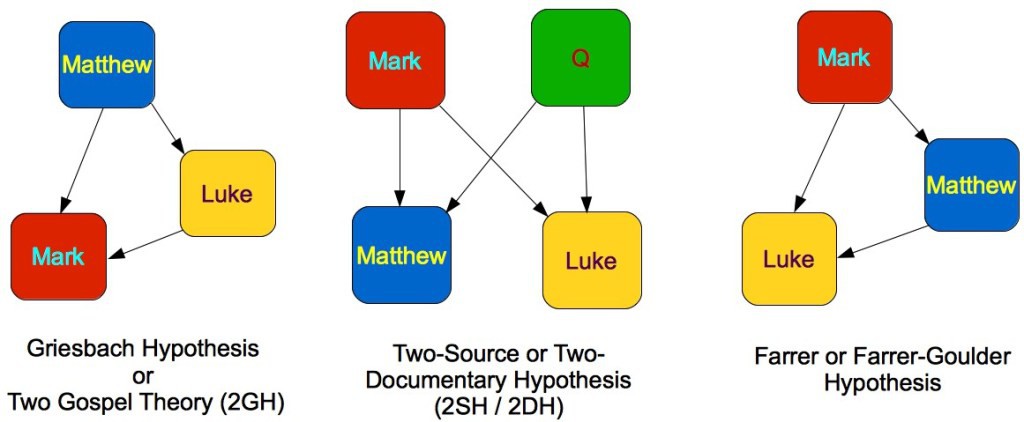
Matthias Klinghardt responded to Mark Goodacre’s 2002 book, The Case Against Q, with an article proposing a Marcionite solution to the Synoptic Problem: “The Marcionite Gospel and the Synoptic Problem: A New Suggestion” published in Novum Testamentum, 2008.
For those of us who like to be reminded, here are the traditional theories on the Synoptic Problem:
The Griesbach or Two-Gospel theory — that Mark was the last gospel to be composed — is a minority view. Recently published proponents are William R. Farmer, Allan McNicol and David Peabody (Klinghardt, p.2).
Arguments for Markan priority — summed up in Goodacre’s book as the case against the Griesbach hypothesis — have persuaded most scholars so for the purposes of this discussion Klinghardt [MK] does not call this into question. It is the major part of The Case Against Q that has proved controversial and that MK addresses. Criticism against Goodacre’s thesis has also come from
- John S. Kloppenborg (2003),
- F. G. Downing (2001),
- Paul Foster (2003),
- Christopher M. Tuckett (2004) (review)
- and C. S. Rodd (2003) (review).
- (The above are referenced by MK. Other responses can be found via Mark Goodacre’s site.)
MK begins by noting two positive arguments supporting Goodacre’s argument for the Farrer hypothesis (also known as the Farrer-Goulder hypothesis) that Mark alone (without Q) was the primary source for both Matthew and Luke, and that Luke also knew and revised Matthew:
- the minor agreements (e.g. both Luke (22:64) and Matthew (26:68) have the mockers of Jesus taunt with “Who is it who struck you?”, but this is not found in Mark)
- the hypothetical nature of Q
On the question of the minor agreements MK sides with Goodacre:
As for the minor agreements, Goodacre has a strong point insisting on the principal independence of Matthew and Luke according to the 2DH. This excludes the evasive solution that, although basically independent from one another, Luke knew and used Matthew in certain instances.
Methodologically, it is not permissible to develop a theory on a certain assumption and then abandon this very assumption in order to get rid of some left over problems the theory could not sufficiently explain. The methodological inconsistency of this solution would be less severe, if “Q” existed. But since “Q” owes its existence completely to the conclusions drawn from a hypothetical model, such an argument flies in the face of logic: it annuls its own basis.
This is the reason why Goodacre’s reference to the hypothetical character of “Q” carries a lot of weight. More weight, certainly, than Kloppenborg would concede: he tries to insinuate that Mark is as hypothetical as “Q”, since Mark “is not an extant document, but a text that is reconstructed from much later manuscripts.” This exaggeration disguises the critical point: the hypothetical character of the “document Q” would certainly not pose a problem, if “Q” was based on existing manuscript evidence the way Mark is.
It is, therefore, important to see that these two objections are closely related to each other: They prove that the minor agreements are, in fact, “fatal to the Q hypothesis”. (my formatting)
But there are problems with thinking that Luke knew Matthew, as MK notes: Continue reading ““The Marcionite Gospel and the Synoptic Problem: A New Suggestion””

